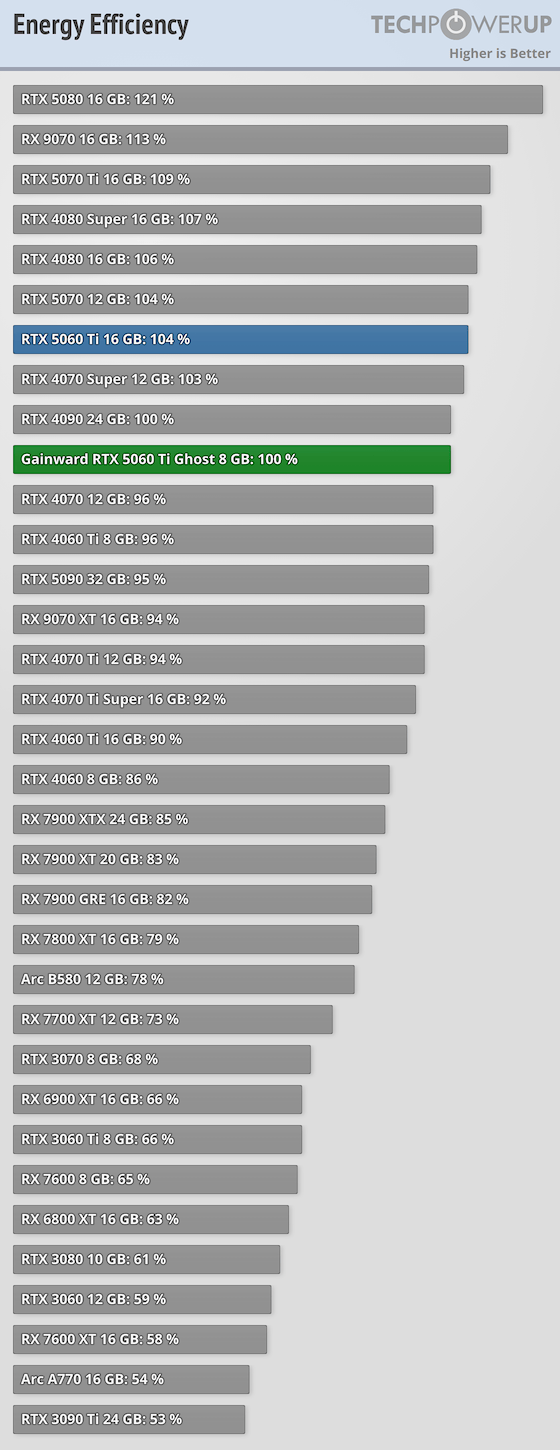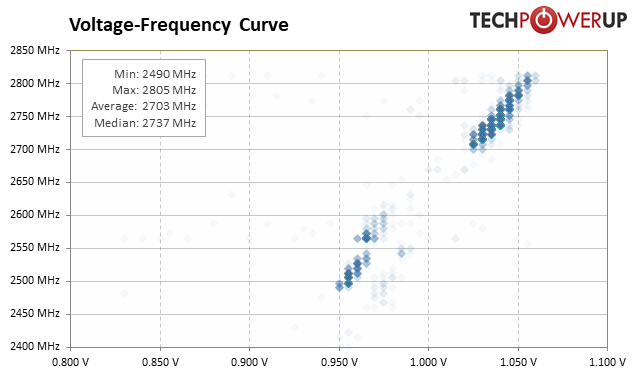 225
225
NVIDIA GeForce RTX 5060 Ti 8 GB Review - So Many Compromises
Overclocking & Power Limits »Energy Efficiency
Energy Efficiency calculations are based on measurements using Cyberpunk 2077, Stalker 2 and Spider-Man 2. We record power draw and FPS rate to calculate the energy efficiency of the graphics card as it operates.
Voltage Frequency Curve
The card will dynamically adjust clocks and voltage based on render load, temperature, and other factors.For the graph below, we recorded all GPU clock and GPU voltage combinations of our 1440p resolution benchmarking suite. The plotted points are transparent, which allows them to add up to indicate more often used values. A light color means the clock and voltage combination is rarely used, and a dark color means it's active more often. The minimum and maximum values are 99th and 1st percentile, so outliers are excluded.

Clock States
| Clock Frequencies & Voltage | |||
|---|---|---|---|
| GPU Clock | Memory Clock | GPU Voltage | |
| Idle | 22 MHz | 51 MHz | 0.650 V |
| Multi-Monitor | 35 MHz 21 to 180 MHz | 101 MHz | 0.650 V |
| Video Playback | 434 MHz 66 to 765 MHz | 55 MHz 51 to 101 MHz | 0.700 V 0.685 to 0.710 V |
| Furmark | 2362 MHz 2347 to 2460 MHz | 1750 MHz | 0.902 V 0.900 to 0.915 V |
| Gaming (Cyberpunk 2077) | 2716 MHz 2715 to 2722 MHz | 1750 MHz | 1.025 V 1.025 to 1.030 V |
| Gaming (Stalker 2) | 2716 MHz 2715 to 2722 MHz | 1750 MHz | 1.025 V |
| Gaming (Spider-Man 2) | 2767 MHz | 1750 MHz | 1.045 V |
| Ray Tracing (Cyberpunk 2077) | 2733 MHz 2722 to 2737 MHz | 1750 MHz | 1.035 V |
| V-Sync (Cyberpunk 2077) | 1767 MHz 1680 to 1785 MHz | 1750 MHz | 0.810 V 0.790 to 0.815 V |
| Gaming (25 Games) | 2703 MHz 2490 to 2805 MHz | 1750 MHz | 1.017 V 0.840 to 1.055 V |
Aug 2nd, 2025 06:02 CDT
change timezone
Latest GPU Drivers
New Forum Posts
- STAR CITIZEN - RSI POLARIS Project (51)
- Free Games Thread (4839)
- memory used for store firmware in adapters wifi usb (6)
- Weird issue with Worms: Armageddon on NV GPUs (11)
- Question about Intel Optane SSDs (91)
- Windows 12 (245)
- My UPS keep sending alarm when I game (39)
- What are you playing? (24030)
- What's your latest tech purchase? (24429)
- HELP (0)
Popular Reviews
- ASUS ROG Crosshair X870E Apex Review
- MSI Claw 8 AI+ A2VM Review
- Montech X5 Review
- Orbital Pathfinder Review
- Herman Miller Logitech G Embody Review - No Pain, No Gain
- Lenovo Legion 5i (15IRX10) Review - Feature-Rich and Wallet Friendly
- Lian Li HydroShift II LCD-C 360TL Review
- Upcoming Hardware Launches 2025 (Updated May 2025)
- Noctua NF-A12x25 G2 PWM Fan Review
- Lian Li O11 Dynamic Mini V2 Review
TPU on YouTube
Controversial News Posts
- AMD's Upcoming UDNA / RDNA 5 GPU Could Feature 96 CUs and 384-bit Memory Bus (138)
- AMD Radeon RX 9070 XT Gains 9% Performance at 1440p with Latest Driver, Beats RTX 5070 Ti (131)
- Intel "Nova Lake-S" Core Ultra 3, Ultra 5, Ultra 7, and Ultra 9 Core Configurations Surface (110)
- DDR6 Memory Arrives in 2027 with 8,800-17,600 MT/s Speeds (102)
- NVIDIA to Debut GeForce RTX 50-series SUPER GPUs by Christmas (101)
- AMD Sampling Next-Gen Ryzen Desktop "Medusa Ridge," Sees Incremental IPC Upgrade, New cIOD (97)
- Intel CEO Confirms SMT To Return to Future CPUs (95)
- NVIDIA Becomes First Company Ever to Hit $4 Trillion Market-Cap (94)